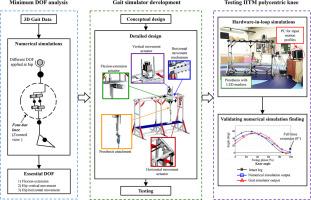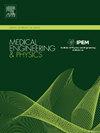结构紧凑、成本效益高的步态模拟器,可减少对人体测试的依赖,推动假肢开发:开发、验证和应用
IF 1.7
4区 医学
Q3 ENGINEERING, BIOMEDICAL
引用次数: 0
摘要
步态模拟器在评估假肢膝关节物理原型的性能、验证数值模拟结果以及减少假肢开发过程中对用户试验的依赖方面发挥着至关重要的作用。然而,由于一方面复杂的高自由度(DOF)系统开发需要大量资金投入,另一方面用于精确模拟的 DOF 不足,因此其实际应用受到了限制。在这项研究中,我们评估了步态模拟器应具备的大腿部分最小 DOF,以便以经济有效的方式测试假肢膝关节的性能。起初,我们使用三维步态数据和不同的大腿阻尼DOF,对假肢与IITM多中心膝(IPK)的摆动阶段进行了数值模拟,以确定步态模拟器的基本DOF。通过将不同的阻滞 DOF 与六 DOF 理想情况进行比较,发现只有矢状面运动,即屈伸、垂直平移和水平平移,才足以测试假肢膝关节。随后,我们开发了一种紧凑型模块化步态模拟器。使用步态模拟器对IPK进行了硬件在环模拟,以证明其在评估义肢膝关节性能方面的有效性,验证了IPK在脚跟接触前完全伸展而无需伸展辅助的能力。此外,IPK的伸展止挡需要重新设计,以便在膝关节在脚跟接触前完全伸展时有效吸收冲击能量。这些发现强调了具有成本效益的步态模拟器在假肢开发中的重要性,并减少了对用户试验的依赖。本文章由计算机程序翻译,如有差异,请以英文原文为准。

A compact and cost-effective gait simulator to advance prosthesis development with reduced reliance on human subject testing: Development, validation and application
Gait simulators play a crucial role in assessing the performance of physical prototypes of prosthetic knees, validating numerical simulation findings, and reducing dependency on user trials during prosthesis development. However, their practical application is limited because of substantial capital investment required for sophisticated high degrees-of-freedom (DOF) system development on one side and insufficient DOF for accurate simulation on the other. In this study, we evaluated the minimum DOF of thigh segment that a gait simulator should have to test the performance of prosthetic knees in a cost-effective manner. Initially, numerical simulations of swing phase of prosthetic leg with IITM polycentric knee (IPK) using 3D gait data and with different arrested DOF of the thigh were performed to identify the essential DOF of gait simulator. By comparing different cases of arrested DOF with the six-DOF ideal case, it was revealed that only sagittal plane movements, namely flexion-extension, vertical translation, and horizontal translation, are sufficient to test prosthetic knees. Subsequently, a compact and modular gait simulator was developed. Hardware-in-loop simulations of the IPK using the gait simulator were used to demonstrate its effectiveness in assessing the performance of prosthetic knees, which validated the ability of the IPK to extend completely without an extension assist before heel contact. Additionally, it was exposed that the IPK's extension stop needs redesigning to effectively absorb the impact energy when the knee extends completely before heel contact. These findings emphasize the significance of a cost-effective gait simulator in prosthesis development and reduce dependency on user trials.
求助全文
通过发布文献求助,成功后即可免费获取论文全文。
去求助
来源期刊

Medical Engineering & Physics
工程技术-工程:生物医学
CiteScore
4.30
自引率
4.50%
发文量
172
审稿时长
3.0 months
期刊介绍:
Medical Engineering & Physics provides a forum for the publication of the latest developments in biomedical engineering, and reflects the essential multidisciplinary nature of the subject. The journal publishes in-depth critical reviews, scientific papers and technical notes. Our focus encompasses the application of the basic principles of physics and engineering to the development of medical devices and technology, with the ultimate aim of producing improvements in the quality of health care.Topics covered include biomechanics, biomaterials, mechanobiology, rehabilitation engineering, biomedical signal processing and medical device development. Medical Engineering & Physics aims to keep both engineers and clinicians abreast of the latest applications of technology to health care.
 求助内容:
求助内容: 应助结果提醒方式:
应助结果提醒方式:


